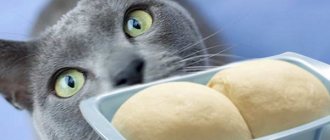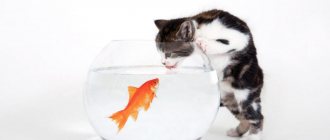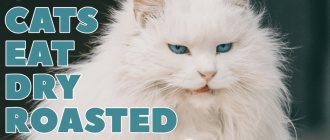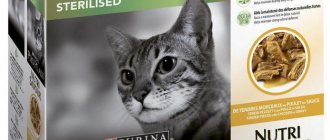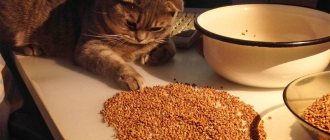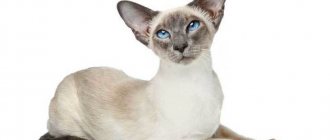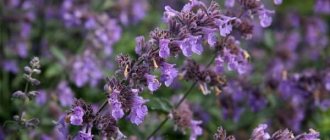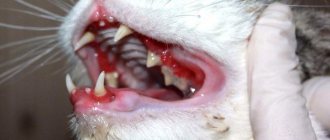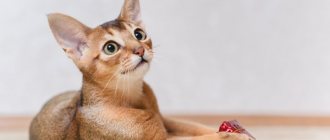Having decided to feed your cat homemade natural food, you need to clearly understand all the responsibility that falls on the owner’s shoulders for the cat’s health. Many people immediately wonder if cats can have rice, buckwheat and other grains. Which meat is best and in what form to eat vegetables.
In ready-made food, everything is simple, you buy it, feed it, and the manufacturer takes care of the composition. But there are also some nuances, the first of which is price. But many simply believe that homemade food for a cat will be healthier and it is difficult to convince them of this, and is it necessary to do this?
© shutterstock
Useful properties of rice
Rice is good for cats because:
- Normalizes the functioning of the digestive system. If your pet has diarrhea or stool disorders, eating small portions of porridge helps get rid of unpleasant symptoms, prevents dehydration and the development of diarrhea (in a healthy animal).
- Provides carbohydrates. The cat remains active and energetic.
- It is a source of vitamins and minerals. Prevents deficiency of zinc, silicon, phosphorus, magnesium.
- Easier than other cereals to be absorbed by the body. Can be used as a natural medicine for a number of pathologies of the gastrointestinal tract.
- It does not contain gluten, so it is suitable for feeding animals intolerant to this substance.
Benefits of cereals
Various cereals must be included in a cat’s diet. As for rice, it contains a large amount of useful vitamins and minerals; it is a source of magnesium and phosphorus, silicon and zinc, as well as many useful vitamins. But despite all its benefits, it is impossible to give a cat rice in large quantities, since it has a fastening property that can cause constipation in a cat.
Rice porridge will serve as an excellent source of carbohydrates for the cat's body. She needs them in small quantities, much less than protein. Thanks to a sufficient supply of carbohydrates, the cat always remains active and cheerful, she plays, runs and has fun.
In addition to rice, a cat's diet should include the following cereals::
- buckwheat;
- corn;
- oatmeal;
- wheat;
- artek
Rules for consumption and inclusion in the diet
Before introducing this product into your cat's menu, consult your veterinarian.
If your animal begins to become constipated or feels worse when eating porridge, remove it from the diet and consult a doctor.
Give your pet only refined white rice. Brown or red are less digestible. The rest of the feed should consist only of protein products (meat, poultry or fish).
Only white rice should be used to feed cats.
Daily norm
Porridge should be given no more than once a week. The grain product should account for no more than 25% of all calories consumed by the cat. If you prefer to give your pet rice water, do not pour more than 1/3 cup at a time.
Restrictions
You will have to give up rice if your cat is often constipated. The grain will worsen the pet's condition. Rice porridge should not be given to babies whose digestive system has not yet developed. Kittens may not digest the product, which will lead to poor health, nutritional deficiency, and underdevelopment.
What types of cat food are there?
There are a number of specific rules that must be followed when feeding cats.
There are two types of food designed for pets. The choice of the owner depends on the capabilities and lifestyle that the person himself adheres to.
The first type of food is natural feeding. It’s worth mentioning right away that natural food does not imply giving scraps to the animal from the human table. Natural food (natural food) is food prepared separately for the pet with a selection of types of meat and vegetable components. Feeding your cat natural food at home means that all food should be prepared without adding any spices or salt.
When feeding natural food, it is necessary to pay special attention to the balance of important components, as well as regularly introduce vitamin and mineral supplements, which make it possible to prevent the development of a deficiency of a particular nutrient
The second type of food is dry granulated food and wet food made in production. Companies that produce high-quality feed take as a basis the products from which natural feed is produced. The main distinguishing feature of ready-made food is its long shelf life. This is both good and bad at the same time, because in order for the food to retain its properties for a long time, it is necessary to add specific substances - preservatives. How to properly feed a cat with dry food should be recommended by a veterinarian after a thorough examination of the animal. This is primarily due to the fact that manufacturers of high-quality food have a number of developed lines specifically for a certain type of pet. Dry food is available for neutered and sick cats, as well as for small kittens, pregnant cats, and older animals.
In addition, it is important to choose super-premium quality food rather than economy class food, since cheap food uses products of dubious quality and a large number of flavoring agents.
There are a number of basic rules regarding the organization of a cat's diet.
- It is not recommended to feed your cat dog food due to the difference in calories and protein/fat/carbohydrate percentages. Dogs are omnivores, and the amount of energy in food is taken from this position. In addition, the amino acid taurine is not added to dog food, because it is synthesized independently in the dog’s body. In adult cats, the body cannot produce the necessary amino acid and when feeding the cat with dog food, a deficiency of this element occurs. As a result of a lack of taurine in the cat's body, problems with the cardiovascular system develop.
- It is not advisable to give an adult cat milk in its pure form, which is due to the inability to digest lactose since in adulthood cats do not have a special enzyme to break it down. This may cause vomiting and diarrhea.
- Mixed feeding is also not recommended, as it causes a large number of health problems. With frequent changes in food, the body of a domestic cat cannot adapt normally, and the functioning of the digestive tract is disrupted. Often cats on mixed feeding suffer from electrolyte imbalance and increased stress on the renal structures. Constipation or diarrhea, chronic inflammatory processes in the stomach and intestines develop.
Find out more about feeding your cat dry food >>>
Cooking methods
You can give your cat rice water.
To prepare the drink, take 2 tbsp. l. cereals and boil for half an hour in 100 ml of clean water. Then strain the resulting product, carefully squeezing out the raw materials.
It is also allowed to give cereal in the form of porridge.
Cook the cereal until softened.
It is prohibited to add salt or spices during the cooking process. You cannot season the finished dish with sauces. They contain large amounts of fat, salt, and synthetic additives. In addition, such dressings may contain pepper, onion or garlic, which are harmful to cats’ digestion. The porridge is boiled in water, after which boiled meat (veal, rabbit, turkey) or offal (stomachs, beef or chicken hearts) is added to it.
It is recommended to add boiled meat, offal and vegetables to rice porridge.
You can add a small amount of boiled or steamed vegetables (carrots, zucchini, pumpkin or broccoli).
It's better not to feed
All so-called “instant” cereals are forbidden for cats, since they contain a lot of sugar - the most harmful product for a cat’s stomach, as well as cereals that are simply not absorbed by the animal’s body.
Semolina
Many owners are sure that semolina with milk is necessary for the growing body, so they often treat their pets to such porridge. They continue to feed an adult cat this product, adding meat or fish to it, which causes irreparable harm to the animal’s body. Numerous studies have proven that semolina is pure starch, which does not provide any benefit. In addition, it contains a lot of gluten, which makes the product too heavy and takes a long time to digest.
Millet
Another harmful and heavy grain is millet. Even when cooked in water, it is quite high in calories and is practically not absorbed by the cat’s body.
Corn porridge
Corn grits contain many microelements and vitamins, but they are absolutely not suitable for regular feeding of cats. Veterinarians claim that 90% of digestive problems are caused by this porridge, since it is not only poorly digested, but also causes flatulence and constipation.
Precautions and possible harm
Cats are predators. For normal functioning, they require a large amount of protein, and need very little carbohydrates. Rice puts a strain on the pancreas and liver, and if consumed in excess, causes disruption in the functioning of these organs.
An excess of grains in the body leads to a lack of nutrients and deterioration of the pet’s health. The cat will grow old faster and die.
If there is too much rice in a kitten's diet, it will grow up underdeveloped, weak, and sickly.
In addition, animals that regularly consume porridge suffer from a lack of essential amino acids. Some veterinarians consider rice to be an empty product, useless for cats.
Cats eat grains to fill their empty stomachs. Due to a lack of nutrients, the animal may eat too much, trying to replenish the reserves of necessary micro- and macroelements. Because of this, weight gain and obesity are observed.
How to choose the right menu
Since cats are predatory animals, they need to be fed accordingly. More than half of their diet should be meat. It could be turkey, chicken, beef. It is better to boil and twist the meat. Raw meat should not be fed to avoid the possibility of helminth infection. If you think that your cat is still a predator and should receive raw meat in its diet, then it can and should be frozen before consumption. Then defrost and, already defrosted, add it to your pussy’s menu.
What medications should I give?
The rate of restoration of normal stool increases with an integrated approach to treatment.
To protect the intestinal walls, you can give the kitten strengthening decoctions:
- A decoction of chamomile, St. John's wort or other plants. They are usually sold in pharmacies as a complex set of various herbs.
- A decoction of oak bark has the strongest astringent effect.
They are brewed like this:
- Pour 1-2 tablespoons of herbs into a glass.
- Pour boiling water over it.
- Let it brew for 30-40 minutes.
- Strain the broth.
To eliminate toxins, which is very important for allergies and poisoning, absorbents are used:
- Activated carbon – tablet or half.
- Enterosgel – ½ teaspoon.
Antibiotics are used to destroy pathogenic microorganisms:
- Furazolidone.
- Smecta.
To destroy worms, anthelmintic drugs are needed:
- Prazicide.
- Vacation.
- Alben.
For viral infections, antiviral drugs are used:
- Fosprenil.
- Ribotan.
- Camedon.
